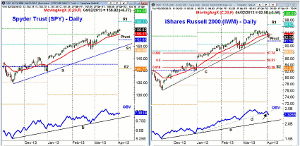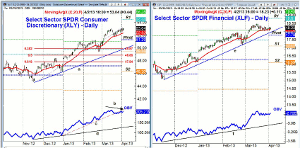The recent divergence between the large- and small-cap ETFs may be an early warning of a correction, says MoneyShows’s Tom Aspray, and he outlines the key quarterly pivot levels that traders and investors should be watching.
Stocks closed mixed Tuesday and the market internals were weaker than prices for the first time all year. The Dow Industrials and S&P 500 were both up over 0.5% but more stocks declined than advanced. This now makes this week’s close more important.
The weekly chart I featured in the most recent Week Ahead column reviewed the spring market corrections that have occurred over the past three years. One of the early warning signs of these corrections was a sharply lower weekly close. This week we have plenty of economic news and Tuesday’s numbers helped support the market. Today we get the ADP Employment Report, which may give us some insight on Friday’s monthly jobs report.
This year, the economic and technical picture currently suggests that a correction may be more like 2012, than 2011. Once a near-term top is completed, we will be able to zero in on the key support levels and the quarterly pivot levels for the 2nd quarter will play an important role.
The table provides not only the quarterly pivot level but also the two pivot resistance and support levels along with the quarterly close. When prices are above the quarterly pivot level, it is a positive sign, so a drop below the pivot levels will be another sign that a correction is underway.
A weekly close below the pivot level will turn the focus on the S1 support levels, and as these examples demonstrate, they often coincide with Fibonacci support levels. These pivot levels should also be used to analyze the key sector ETFs and help you in determining stop levels.
Chart Analysis: The chart of the Spyder Trust (SPY) shows that it gapped above the quarterly pivot level to start off the first quarter of 2013.
- The blue line on all of the charts is the pivot level, which is at $152.65 on the chart and at $152.75 on the table.
- This difference is caused by using different platforms, and it should be thought of as a zone of support or resistance more than an exact level.
- The SPY has been respecting the rising 20-day EMA, which is now at $155.17.
- The last important price low was at $153.59 with the next important support at the quarterly pivot.
- The daily uptrend is at $149.53.
- The quarterly R1 is in the $160.31-$160.77 area.
- The on-balance volume (OBV) did confirm the highs on March 14 but has not yet confirmed the recent highs.
- The OBV support to watch is at the uptrend, line b.
The iShares Russell 2000 (IWM) has started to diverge from the SPY. The two consecutive lower closes have violated the daily uptrend, line c, suggesting a short-term top may be in place.
- The quarterly pivot is at $91.50/$91.81, which if violated will turn the focus on the S1 support at $88.03.
- The 38.2% Fibonacci support from the high at $94.96 is at $87.74.
- The 50% retracement support is at $86.51 with the 61.8% support just above the quarterly S2 level.
- The OBV did not form any divergences at the recent highs but has now broken its short-term uptrend, line d.
- A drop below the longer-term support, line e, would be more negative.
- There is initial resistance now in the $93-$94 area and a close above $94.66 is needed to reverse the negative short-term momentum
NEXT PAGE: 2 Top-Performing Sectors
|pagebreak|The Select Sector SPDR Consumer Discretionary (XLY) is one of the top bull market sectors and made new bull market highs Tuesday at $53.16.
- The rising 20-day EMA is at $52.32 with the last swing low at $51.47.
- This is just above the quarterly pivot at $51.37/$51.29.
- Using Tuesday’s high, the 38.2% Fibonacci support is at $49.87 along with the daily uptrend, line a.
- Of course, if XLY makes new highs, these levels will need to be adjusted.
- The S1 support level is at $49.45 with the 50% support at $48.86.
- The daily OBV has formed lower highs (line b) and has broken its short-term uptrend, line c.
- A drop below the late March low would confirm the divergence with longer-term support at line d.
The Select Sector SPDR Financial (XLF) has been the bull market’s second best performing sector. It has traded in a narrow range over the past two weeks and has held the 20-day EMA.
- The daily uptrend, line e, is now at $17.95 with the quarterly pivot at $17.81/$17.79.
- The S1 level is at $17.11, which also corresponds to the February lows.
- There is initial resistance at $18.37 with the R1 resistance at $18.81.
- The OBV is still acting very strong as it surged to significant new highs in March.
- The OBV is trying to break out of its short-term trading range, which would be positive.
What it Means: The deterioration in the technical outlook for the IWM may be warning of a short-term top and an impending correction. This week’s close will be important and a close below last week’s lows would be a sign of weakness.
How to Profit: No new recommendation.
Portfolio Update: On the remaining long position in the iShares Russell 2000 (IWM) from $82.55, sell at $92.94 or better and use a stop at $92.42.























